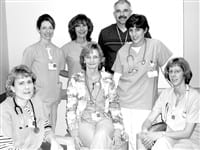Giving the Gift of Life – This Holiday, Think About Making an Organ Donation
Q: My sister lives out in California and is awaiting a kidney transplant. I recently saw something on local television about a program called Kidney Paired Donation. What can you tell me about that?
A: Kidney Paired Donation (KPD) is a relatively new program started in 2010 and operated through the Organ Procurement and Transplantation Network, which is managed by the United Network for Organ Sharing. It’s a transplant option for patients with an incompatible living donor. For example, a candidate like your sister might have a friend or family member who wants to be her living donor, but they don’t match. Transplantation is still possible through KPD by linking together pairs of compatible people. A KPD exchange can involve two, three, or more pairs, resulting in more lives saved.
Q: How long does a patient normally wait for a new kidney when placed on the national organ-transplant waiting list?
A: Once a patient is added to the national organ-transplant waiting list, he or she may receive an organ fairly quickly or wait many years. In general, the average time frame for waiting can be three to five years at most centers and even longer in some geographical regions of the country. Also, while participating in Kidney Paired Donation, although your chances of getting a kidney are increased, it is still not a guarantee that you will receive a kidney. It could happen within a week, two weeks, or much longer, or even never.
Q: I understand the need is great today for organs to be transplanted. Why?
A: As of this past November, there were 116,439 men, women, and children awaiting lifesaving organ transplants on the national transplant waiting list, about 150 of whom are Baystate Medical Center patients waiting for kidneys, which is all that we transplant at Baystate. So far this year, there have only been 26,034 organ transplants nationwide, and last year, more than 7,000 candidates died while on the waiting list.
As for why, the number of deceased donors has remained relatively stable over the past 10 to 15 years. While there have been small increases, it is nowhere near the increase in demand for organs. Also, there are fewer deaths from accidents today because cars are so much safer now and more people are using their seatbelts. And, in general, people are just more safety-conscious.
The majority of organ and tissue donations are from deceased donors. But some organs and tissues, mainly kidneys and livers, can be donated while the donor is alive. Today, about four out of every 10 donations come from a living donor. Most living donations occur among family members or between friends, while others are simply altruistic living donors who want to give the gift of life to someone they don’t know.
Q: I would like to start the new year by becoming an organ donor. How can I do that?
A: Making your wishes known is easy. Potential donors need only to sign a donor card, indicating their wishes on their driver’s license, or register online at donatelifenewengland.org. However, while a signed donor card, online registration, and a driver’s license with an organ-donor designation are legal documents, organ and tissue donation should always be discussed with family members prior to any donation, so they are well aware of your wishes.
Q: Someone told me I’m too old to become a donor. Is that true?
A: While you didn’t share your age with us, anyone can be a potential donor regardless of age, race, or medical history. All major religions in the U.S. support organ, eye, and tissue donation and see it as the final act of love and generosity toward others.
Q: If I were to become a living donor, how difficult is the surgery?
A: It used to be that the living donor had a much bigger operation with a longer recovery than the recipient. Today, that has changed, and donor surgery is now performed laparoscopically with a very small incision, and you usually go home in one to two days. Surgery for our recipients hasn’t changed much in the past 50 years except for minor modifications. It is still open surgery involving making an incision about five inches long in the groin followed by a three- to four-day stay in the hospital.
Q: If I wanted to explore the possibility of becoming a living donor for someone, where would I begin?
A: I am going to assume that you are not compatible with your sister for kidney donation. So, let’s say you want to become an altruistic donor and become part of the Kidney Paired Exchange. After an initial screening on the phone, we would bring you into the office to conduct an exam to make sure you have normal kidney function and are free from infections or potential cancers that can be transferred to the recipient. There are other considerations as well. If you are donating to someone you know, then we want to be sure you are not being pressured or coerced by that person. And we want to be sure you are financially able to donate without the fear of losing your job because of time taken off from work.
Q: Will I incur any costs if I become a donor?
A: There is no cost to the donor or their family for organ or tissue donation.
Q: What is my next step?
A: To learn more about becoming a living kidney donor, call Baystate Medical Center’s Transplant Services at (413) 794-2321. Or, to learn more about organ and tissue donation, contact LifeChoice Donor Services at (800) 874-5215.

